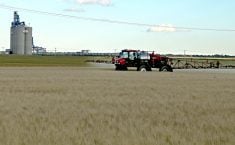Winnipeg, June 19 (MarketsFarm) – Corn and soybean futures at the Chicago Board of Trade may have run into some profit-taking resistance, but underlying concerns over wet fields and lost acres should keep the general uptrend in place heading through the summer.
“I don’t think this weather story is anywhere near over,” said Preston Zacharias, of CHS Hedging’s Russell Consulting Group in Minnesota, adding “it’s not like a drought, when you can fix it with one rain.”
“There’s an outright emergency here, and I can’t believe the market is so complacent with it,” said Zacharias pointing to the wet Midwestern weather and slow planting pace.
Read Also

New coal mine proposal met with old concerns
A smaller version of the previously rejected Grassy Mountain coal mine project in Crowsnest Pass is back on the table, and the Livingstone Landowners Group continues to voice concerns about the environmental risks.
“I think the Prevent Plant story is bigger than the market wants to acknowledge, and I think the yield penalty story is bigger than the market wants to acknowledge.”
With only 92 per cent of the United States corn crop seeded as of June 16 that would infer that eight million acres were unplanted. Much of what was seeded went in the ground later than normal, which cuts into the yield potential.
By his math, Zacharias estimated that yields would fall somewhere between 135 and 150 bushels per acre on a national level, with a possible loss to the overall crop of about three billion bushels. The U.S. Department of Agriculture is currently forecasting corn yields at 166 bushels per acre.
As a result, Zacharias said any down days in corn were buying opportunities noting “the ship has sailed on buying cheaper corn; the longer term trend is pointing higher.”
Soybean seeding is also running well behind normal across the U.S., with the lateness likely cutting into yields.
Zacharias said large old crop supplies must still be worked through, but the reduced production prospects should also be supportive. “The beans may have their own story, but we have to work through a billion bushels first to get to the good stuff.”
From a chart standpoint, “the only resistance left on corn is basically US$5.19, the last high from about five years ago, and I don’t even think that stops it,” said Zacharias.
For soybeans he saw more resistance, with US$10.60 “a formidable resistance on the front month.”
Soybeans will also continue to react to trade news. “If we have a trade deal, beans are a dollar too cheap instantly,” said Zacharias. Although he added that market participants were getting tired of the back-and-forth lack of direction on the trade front.
Looking at wheat, Zacharias thought prices were cheap relative to corn. Kansas City wheat usually trades at premium of at least a dollar per bushel over corn, but the front month wheat contract was only 16 cents above the nearby corn futures on June 19. “Just on a relative price basis, wheat is a little too cheap here.”
If corn is rationed, livestock and feeders and ethanol plants will look to alternatives, which would cut into wheat stocks and support prices, said Zacharias noting “wheat is a passenger on the corn train.”

















